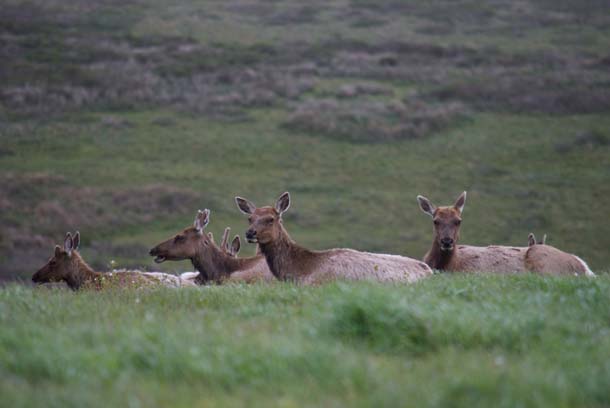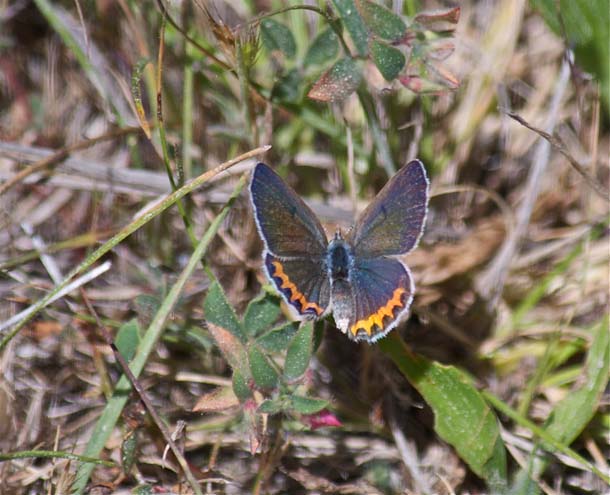In point of fact, the greater one’s science, the deeper the sense of mystery.
–V. Nabokov in Strong Opinions, 1973.
Muddy Hollow (0.3 mi) to Estero Trail south (4.7 mi) to Glenbrook (0.7 mi.) to Muddy Hollow Road (1.8 mi.) loop. 7.5 miles total.
Conditions: Clear , calm, comfortable temperature, excellent visibility. Hiked on June 3, 2012
Check out this and other hikes Jules has taken on this Google map. The most recent hike is in blue; others are in red.
The southern extent of the Estero Trail is the newest trail on the peninsula. Branching off the Muddy Hollow Trail about 0.3 miles from the parking area, it connects to the inner reaches of Limantour Estero, a fairly easy stroll through riparian and northern coastal scrub habitats.
The early hours are the best time to begin any hike, especially on a sultry morning like this one. In early June, birds are still singing and the morning air is slightly damp and cool. After crossing the alder and willow corridor that follows Muddy Hollow creek, the newly routed trail begins a slow ascent. (Poison oak along the trail’s edge is to be avoided.) After a mile or two, we’ve crossed the hogback that parallels Muddy Hollow and a westerly panorama opens up. The coastal scrub is extensive here, stretching down to the estero’s shore. The outer point at Chimney Rock frames Drake’s Bay and California’s cerulean sky lets the landscape shine.
Off to our left my wife, Meryl, notices a herd of tule elk loafing in a grassy opening amid the coyote brush. The elk were reintroduced to the peninsula in the late 1970s, after more than a century’s absence. This “Limantour herd” was translocated here in 1999 from Tomales Point after that herd reached the carrying capacity of the 2600-acre fenced-off reserve. Although the elk struggled for survival during the first decade or so, as the range converted from annual grassland to coastal scrub and the available forage species increased, the herd began to thrive. The Point Reyes herd is now the largest in California.

We stop for snacks on a grassy knoll above Glenbrook wetland with a unique view of the inner estero and Sculptured Beach far to the south. The marshy lowlands support dense stands of cattail and bulrush, a perfect place to support that secretive marshbird the American Bittern. No bitterns appear or are heard as we chew our granola bars and rehydrate, but a tarted-up painted lady lands on some coyote scat nearby. “What’s a nice lady like you . . .”


At the junction with the Glenbrook Trail, after a magnificent view of the outer peninsula, we veer right to head back. It’s mid-day now, and the path passes through costal scrub intermixed with grassland. The birds are quiet, resting during the heat of the day. But there are insects aplenty–skippers, dragonflies, various butterflies–seemingly following the path,

Among the many butterflies fluttering along the path, perhaps the most common this warm mid-day is a nickel-sized, violet-blue beauty that belongs to a large group of small Lepidoptera known generically as “the blues.” The blues are exceedingly difficult to identify, but some of the males have a bright orange markings (aurorae) on the upper edge of the hind wings that aids in identification and adds to their stunning beauty. I think these are the acmon blues which are restricted in distribution to a narrow strip along the Pacific coast, but even with a photograph in-hand, I am uncertain of the species. Interestingly, the taxonomy of this complex group was untangled by none other than Vladimir Nabokov, one of the 20th Century’s most imaginative novelists and memoirists (Lolita, Pale Fire, etc.). He was also an accomplished naturalist. These brilliant butterflies seem to be a perfect expression of the curiosity and genius that ignited Nabokov’s mind.


- This western (or “Coast Range”) fence lizard (Sceloporus occidentalis) is hunkered at the entrance to a burrow, apparently basking in the sun. The cryptic coloration of its back blends fairly well with the gravelly background. The black markings on the dorsal scales suggest a female; males have blue on the vent, so are commonly known as “blue-bellies.”
By lunchtime, farther along the Glenbrook Trail and about 6 miles into the hike, it has gotten quite warm, maybe 80 degrees F and we encounter some of the creatures that are most comfortable in the heat of the day–a western terrestrial garter snake scuttles across the path, umber skippers flit through the dried grasses, honey bees visit the lotus and lupine flowers along the path’s border.

- Ox-eyed Satyr (Cercyonis pegala boopis), superficially similar to the more common California buckeye, is a California endemic with a “dancing” flight. It is fairly common usually in ungrazed grasslands on the peninsula.
The last 1.8 miles of Muddy Hollow Trail was covered on my Bucklin Trail hike in early April, and has changed little, although the ground is drier and the hum of bumblebees and honeybees provisioning the coyote brush provides a pleasant background strumming as we walk silently back to the car.
Acknowledgements: Thanks to Robert Pyle and Rich Stallcup for help with butterflies and Lorraine Parsons for help with the identification of the glandweed.






